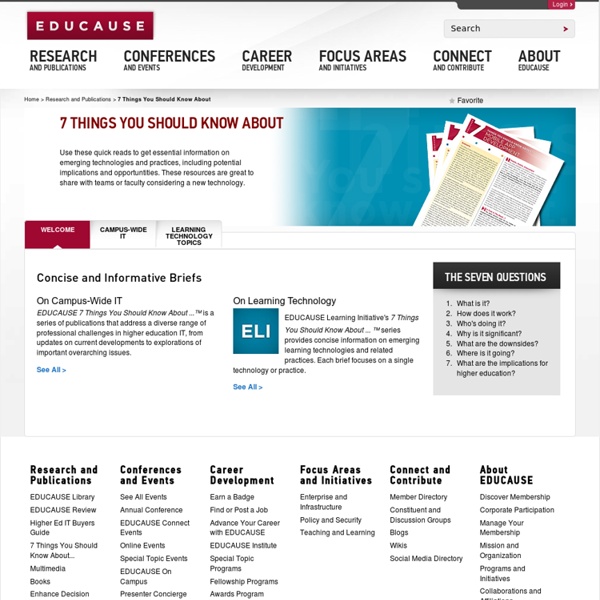



Le blog Efficartes - L'efficacité créative pour tous Open Educational Resources (OER): Resource Roundup Resources by Topic: OER, a part of the global open content movement, are shared teaching, learning, and research resources available under legally recognized open licenses -- free for people to reuse, revise, remix, and redistribute. Why are OER important? Getting Started Sharing Resources The nonprofit Creative Commons offers free, easy-to-use copyright licenses that allow you to specify which rights to your works you want to reserve and which rights you'd like to waive. Quality Considerations With all the promise of OER, some challenges remain. Back to Top How to Find OER Open Lesson Plans, Courses, and Activities 5-Minute Film Festival: 10 Sources for Free Lesson Plans, by Amy Erin Borovoy (2013) Exploring free lesson planning resources can be overwhelming. Open Alternatives to Textbooks
Guides et Stratégies d'Études; Formations Conseils utiles:Les commandes pour imprimer et l'aperçu avant impression (print and print preview) ne montre que les sujets élaboréeset non pas la navigation, les avertissements, les bandeaux publicitaires, etc. Nouvelles et évènements d'octobre:Dix thèmes ont été ajoutés aux guides;Mon profil professionnel (en anglais) viens d'être créé a wwww.josfland.com. L'année 2011: 10,4 million de visiteurs ont consultés 21,7 million de pages en 39 langues. Septembre 2012: 1,2 million de visiteurs (un augmentation de 10%) ont consultés 2,3 million de pages. Me contacter (Les adresses électroniques ne sont absolument pas partagées) What are Open Educational Resources There is no one, standard definition of Open Educational Resources. However, the following broad definition of OERs from OER Commons seems to be generally accepted by the community: Open Educational Resources (OER) are teaching and learning materials that are freely available online for everyone to use, whether you are an instructor, student or self-learner. Examples of OER include: full courses, course modules, syllabi, lectures, homework assignments, quizzes, lab and classroom activities, pedagogical materials, games, simulations, and many more resources contained in digital media collections from around the world. OERs exist within a wider 'Open' movement and context, explored below. The Open Movement Open source (relating to business and technology)Open source softwareOpen source hardwareOpen standardsOpen access (research)Open designOpen knowledgeOpen data Open content Open courseware Open educational resources Open educational practice What are educational resources?
Développer sa mémoire, de la théorie à la pratique Sur son blogue Trouve ta voie, le formateur Marco Bertolini présente « Les 7 clés de la mémoire » , sept principes pour préparer le terrain d’une bonne mémorisation, au moyen d'une carte heuristique et de textes explicatifs. Écrit à l’intention des étudiants qui préparent des examens, cet article permet d'avoir une vue d'ensemble des différents aspects de la mémorisation à prendre en compte lors de la révision des cours. Nous avons jumelé à chacune des clés des ressources en ligne pratiques et gratuites pour les explorer et les mettre en application. Motivation La première étape est de se poser la question des motivations personnelles. En lien avec cette première clé de la mémorisation, il existe d'intéressantes ressources mises en ligne par l'Université Laval : un guide complet sur la motivation, pour la développer ou la maintenir, pour reconnaître les indices d'une baisse de motivation et faire des exercices pratiques pour lutter contre la procrastination. Comprendre Structurer
Bloom's taxonomy Bloom's wheel, according to the Bloom's verbs and matching assessment types. The verbs are intended to be feasible and measurable. Bloom's taxonomy is a classification of learning objectives within education. It is named for Benjamin Bloom, who chaired the committee of educators that devised the taxonomy, and who also edited the first volume of the standard text, Taxonomy of Educational Objectives: The Classification of Educational Goals. Bloom's taxonomy refers to a classification of the different objectives that educators set for students (learning objectives). Bloom's taxonomy is considered to be a foundational and essential element within the education community. History[edit] Although named after Bloom, the publication of Taxonomy of Educational Objectives followed a series of conferences from 1949 to 1953, which were designed to improve communication between educators on the design of curricula and examinations. Cognitive[edit] Knowledge[edit] Comprehension[edit] Application[edit]
Community College Consortium for Open Educational Resources | for Open Educat... Free Online Course Materials | About OCW Classroom 2.0 Learning English Mooc to be launched on FutureLearn The British Council is to offer its first free online course for learning English on the UK massive open online course platform FutureLearn. It is the first course to be delivered by one of the “cultural partners” of the Open University-owned Mooc provider, rather than by a university. Other such partners include the British Library and the British Museum. The course, which will begin this autumn, is aimed at non-native speakers with intermediate levels of English language proficiency, and will include learning about British culture and traditions to enable learners to gain a better understanding of life in the UK. It is not designed to link directly with any UK government-recognised Secure English Language Test, however the British Council said it hoped that participants on the course would “feel confident to then explore options towards taking a SELT”. chris.parr@tsleducation.com Click to rate 1 star out of 52 stars out of 53 stars out of 54 stars out of 55 stars out of 5 0 out of 5 stars
Nets Standards Education technology standards to transform learning and teaching The time for major change in education is now. In a world where rapid advances in technology have a profound impact on the ways we work, communicate and live, education has struggled to keep pace. The ISTE Standards work together to support educators, students and leaders with clear guidelines for the skills and knowledge necessary to move away from the factory model. These are not the typical boxes educators need to check. Empowering connected learners in a connected world As educators, we are preparing students for a future that we cannot yet imagine. Want to know more? How can the ISTE Standards be used? Visit permissions and licensing.
dotEPUB — download any webpage as an e-book